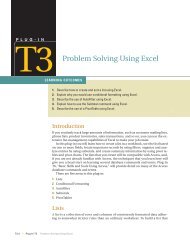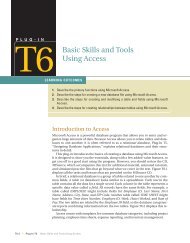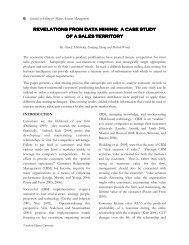The Impact of Stigma: Negative Stereotypes of Salespeople
The Impact of Stigma: Negative Stereotypes of Salespeople
The Impact of Stigma: Negative Stereotypes of Salespeople
You also want an ePaper? Increase the reach of your titles
YUMPU automatically turns print PDFs into web optimized ePapers that Google loves.
Academic Article Fall 2007 41Many commission-compensated salespeoplemay feel they are left with only two choices.<strong>The</strong>y may perceive that they are stigmatizedand discount the likelihood <strong>of</strong> a successful saleoutcome as a consequence <strong>of</strong> the stigmaassociated with their sales position. Thischoice leads to lower effort. <strong>The</strong> secondchoice is to discount or ignore the opinions <strong>of</strong>the customer and focus on completing thetransaction. This strategy may lead toincreases in negative opinions as customersperceive the salesperson is unconcerned withtheir needs. As we suggest next, eventuallythis leads to negative stereotyping <strong>of</strong> thiscategory <strong>of</strong> salespeople or the stigmatization<strong>of</strong> commission-based sales.Our understanding <strong>of</strong> stigmas, as a conditionthat influences interpersonal interactions,comes from the social sciences in general andmarketing in particular (Adkins and Ozanne2005; Link and Phelan 2001). While aconsensus definition <strong>of</strong> stigmatization iselusive, we propose that stigmatization is thecategorization <strong>of</strong> the sales role into astereotyped group and refers to patterns <strong>of</strong>social rejection. Most stigma frameworks(Adkins and Ozanne 2005; Link and Phelan2001) embrace a social explanation forrejection. Signs <strong>of</strong> stigmatization includeexistence <strong>of</strong> an outward indicator <strong>of</strong> class,negative connotations attached to thestereotyped category, and wide dissemination<strong>of</strong> the stigma through popular media.An additional component <strong>of</strong> stigmatization isthat the target <strong>of</strong> this stereotyping must beaware <strong>of</strong> the negative categorization for it tohave an impact on self-image (Oyserman andSwim 2001). It is likely that automobilesalespeople are aware <strong>of</strong> the negative societalconnotations associated with their pr<strong>of</strong>ession.Some evidence <strong>of</strong> this awareness is providedby salespeople’s widespread use <strong>of</strong>euphemisms for their pr<strong>of</strong>ession such as‘account manager’ or ‘problem solver’ in orderto cast the pr<strong>of</strong>ession in a more positive light(Blitzer 1994).A salesperson may or may not react to thestigma depending upon their choices outlinedabove. <strong>The</strong>y may ignore customers and theiropinions, in which case the stigmatizationdoes not matter. Alternatively, thesalesperson may maintain a customerorientation. <strong>The</strong>n, the salesperson’sperception <strong>of</strong> stigmatization is likely to be asignificant influence on the effort expendedsince the negative categorization comes fromthe role referent customer. <strong>Stigma</strong>consciousness theories suggest that awareness<strong>of</strong> stigmatization prevents the target <strong>of</strong> thestigma from “push(ing) themselves to excel inthat domain” (Pinel et al. 2005 p. 486). In asimilar vein, Bussey and Bandura (1999)maintain that targets <strong>of</strong> the stigma may lowertheir effort. This effect leads to our secondhypothesis:H 2 : A salesperson’s stigma-consciousness isinversely related to the salesperson’sself-reported effort.Manager SupportAs boundary spanners, salespeople must try tosatisfy both, customers and the company,which can cause role conflict for thesalesperson (Bagozzi 1980; Johlke and Duhan2001; Singh 1993). In addition, having to faceconstant rejection in selling, salespeople haveVol. 7, No. 4
















